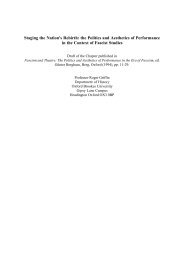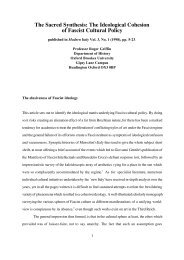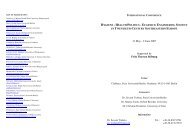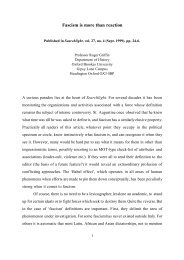Revolution from the Right: Fascism - School of Arts and Humanities ...
Revolution from the Right: Fascism - School of Arts and Humanities ...
Revolution from the Right: Fascism - School of Arts and Humanities ...
You also want an ePaper? Increase the reach of your titles
YUMPU automatically turns print PDFs into web optimized ePapers that Google loves.
turn out on closer inspection to have pursued no radical plan to create a new ruling elite, but<br />
exercised power on behalf <strong>of</strong> conservative forces despite <strong>the</strong> fascist facade <strong>the</strong>y created by<br />
adopting <strong>the</strong> external trappings <strong>of</strong> fascism (leader cult, mass rallies, shirted youth movements<br />
etc.). These ‘parafascist’ regimes include Franco’s Spain (1939-1975), Dollfuss’ <strong>and</strong><br />
Schuschnigg’s Austria (1933-8), Antonescu’s Romania (1940-44), <strong>and</strong> Pétain’s Vichy France<br />
(1940-2). These were indeed ‘counter-revolutionary’, <strong>and</strong> tried to absorb, marginalize or eliminate<br />
not just communism, but ‘real’ fascism as well as a revolutionary threat to <strong>the</strong>ir ascendancy. 11<br />
In Spain, for example, Franco, whose basic concern was to crush <strong>the</strong> Republican forces <strong>and</strong><br />
restore <strong>the</strong> power <strong>of</strong> l<strong>and</strong>ed elites, <strong>the</strong> Monarchy, <strong>and</strong> <strong>the</strong> Church, was careful to absorb <strong>the</strong><br />
genuinely fascist Falange to give his regime an aura <strong>of</strong> dynamism <strong>and</strong> appeal to <strong>the</strong> young it<br />
would o<strong>the</strong>rwise have lacked. In Romania, King Carol II first tried to crush <strong>the</strong> country’s<br />
extremely violent fascist movement, <strong>the</strong> Iron Guard, but its popularity led him to change tack <strong>and</strong><br />
bring some <strong>of</strong> its leaders into government. After his abdication he was succeeded by General<br />
Antonescu who pretended to be prepared to share power with <strong>the</strong> Iron Guard, but <strong>the</strong>n seized<br />
<strong>the</strong> first opportunity to liquidate it by force. These episodes reveal <strong>the</strong> fundamental antagonism<br />
between conservatism <strong>and</strong> fascism however much practical considerations force <strong>the</strong>m into<br />
partnership.<br />
8<br />
A third implication which follows <strong>from</strong> our ideal types is that only two inter-war right-<br />
wing regimes were actually revolutionary <strong>and</strong> hence fascist: Fascist Italy <strong>and</strong> Nazi Germany. 12<br />
It is important to stress, however, that while <strong>the</strong>y share an identical core myth <strong>of</strong> national<br />
rebirth, pr<strong>of</strong>ound differences divide <strong>the</strong> concrete ways in <strong>the</strong> circumstances which brought <strong>the</strong>m<br />
to power <strong>and</strong> <strong>the</strong> ways in which this myth was manifested. For one thing, <strong>the</strong> situations which












